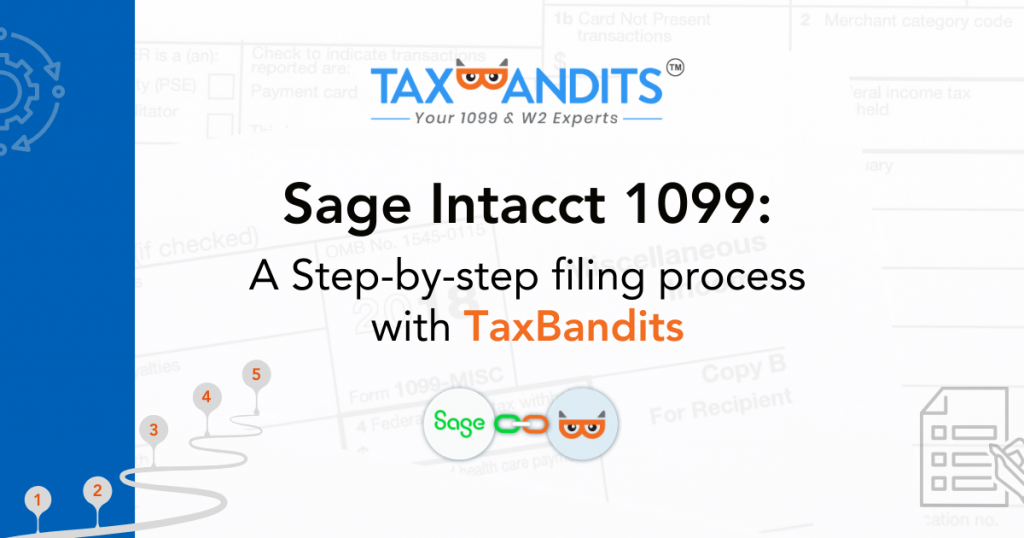Sage Intacct 1099 E-filing Powered by TaxBandits: A Guide

TaxBandits and Sage Intacct have teamed up to simplify 1099 e-filing for every business! The seamless, direct integration allows Sage Intacct clients to transfer their vendor information from their account directly to TaxBandits for the effortless generation of 1099 forms. This eliminates the need for cumbersome spreadsheets and the lengthy process of manual filing and mailing of paper forms.
Let’s take a closer look at this process to see just how simple it is!
Get Started from Your Sage Intacct Account
In Sage Intacct, you have the power to manage 1099 vendors and transactions, review 1099 reports, and make necessary corrections. When you’re ready to e-file, the data is effortlessly transferred to TaxBandits, where you will complete the next steps to finalize the 1099 E-filing process. TaxBandits automatically checks for any errors that need correction to meet IRS or state requirements.
Generate and E-file 1099 Forms in Minutes with TaxBandits
You also have additional services to choose from, such as online access or mailing copies to recipients. After you submit forms to the IRS via TaxBandits, you can conveniently check the status of your submission in your TaxBandits account.
Steps for Enabling 1099 E-filing with TaxBandits
To enable 1099 E-filing, follow these steps:
An admin user should enable Sage Cloud Services in your company subscription. If it’s already enabled, no changes are needed.
Once Sage Cloud Services are enabled, an admin user can navigate to the Accounts Payable Module, Configure Accounts Payable page, and select the checkbox for “1099 E-filing Powered by TaxBandits.”
Creating Batches and Generating Batch IDs
Once the 1099 E-filing feature is enabled, and you have the necessary permissions, you will see a new ‘1099 E-File Submission Transactions’ option in the Accounts Payable menu. Click on it.
Here, you can review all your submission batches and their statuses. To create a new batch, click ‘Add’. Select the year ending date, vendors, entity, and form type, then click ‘E-file’.
A pop-up will appear to show you a summary of the page. You will then be directed to log into TaxBandits, either with your existing account or by creating a new one.
Creating Your TaxBandits Account
Visit the TaxBandits website and create an account by providing your email address, contact name, login password, and phone number. By creating a TaxBandits account, you become an admin user by default, and you can define who has access to it.
Accept the TaxBandits Privacy Policy and Terms of Service, and the tab will close, bringing you back to Sage Intacct. The batch status will initially appear as “in-progress,” indicating that the system is processing your submission.
The batch status will initially appear as ‘in-progress’, indicating that the system is processing your submission.
If the status changes to ‘failed,’ you can follow the action log to review errors and resubmit the batch. When the status changes to ‘submitted’, it means your data has been successfully transferred to TaxBandits.
Click on each ID hyperlink to continue 1099 E-filing in TaxBandits. Here, you’ll verify your company’s business information, check for errors, and perform corrections if needed.
Review the basic business information and click continue to generate your 1099 forms in TaxBandits.
You can address any errors. We recommend updating this information in Sage Intacct. If you proceed to update the information in TaxBandits this will not be reflected in your Sage Intacct Account automatically.
After confirming your selected services, reviewing the summary of 1099 forms, and completing your payment, you’ll receive an order confirmation. Once the IRS or SSA processes your forms, you’ll receive an email and can access your transmitted forms in the Distribution Center.
In conclusion, the integration of Sage with TaxBandits has ushered in a new era of simplicity and efficiency in the world of 1099 E-filing. No more time-consuming manual processes or the hassle of multiple data transfers. With this seamless collaboration, you can streamline your tax filing experience, reduce errors, and ensure compliance effortlessly.
1,558 total views, 3 views today





